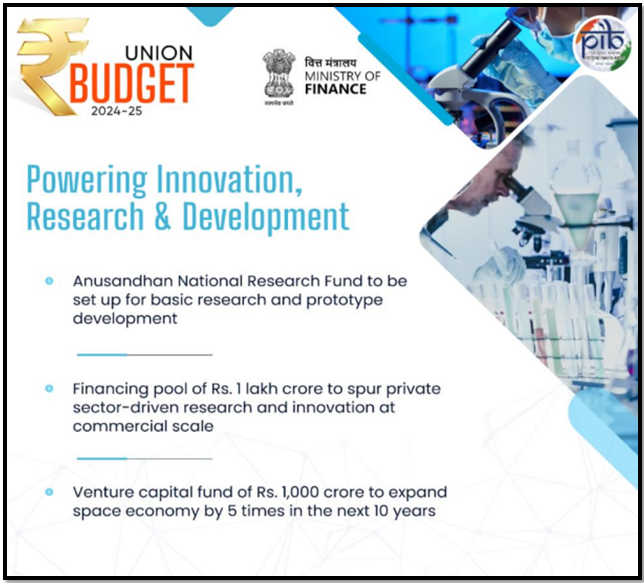SIGNS OF SCIENCE RESEARCH CORPORATISATION
Syllabus:
- GS 2: Government policies and interventions in various sectors
Why in the News?
The Anusandhan National Research Foundation (ANRF) was recently highlighted in the July 2024 Budget, emphasizing its role in fostering innovation by linking research, academia, and industry in India.
Source: PIB
Introduction
- India’s evolving science policy under Prime Minister Narendra Modi’s leadership marks a shift towards market-driven research, emphasizing innovation and self-financing.
- With the establishment of the Anusandhan National Research Foundation (ANRF), the government is increasingly encouraging private sector involvement, raising concerns about the future of curiosity-driven, publicly funded scientific research.
Key Initiatives to Boost Science and Technology
|
Corporatisation of Science Research in India
Background of the Policy Shift
- The Indian government has encouraged research institutions to generate revenue independently by marketing their expertise.
- This shift began with the ‘Dehradun Declaration’ in 2015, led by the Council of Scientific and Industrial Research (CSIR) directors.
Focus on Self-Financing Research
- The policy promotes self-financing research by converting state-owned entities into market commodities.
- Institutes are encouraged to register as Section 8 companies, allowing private investment in research activities.
Implications
- This move aims to reduce reliance on public funding, pushing research centres towards a business model focused on profit generation.
The Anusandhan National Research Foundation (ANRF)
Establishment and Purpose
- The Anusandhan National Research Foundation (ANRF) was established under the ANRF Act of 2023.
- It aims to fund research in India and strengthen connections between research, academia, and industry.
Focus on Research and Prototype Development
- The ANRF is designed to support basic research and prototype development.
- Prototype development is crucial for evaluating the market potential of new products.
Government’s Market-Oriented Approach
- The government’s emphasis on prototype development reflects its focus on market-driven research.
- The finance minister highlighted this in the 2024 Budget, underlining the importance of aligning research with market needs.
Allocation and Source
- The ANRF will receive ₹50,000 crore over five years.
- 72% of this funding is expected from the private sector.
Implications
- The heavy reliance on private funding indicates the government’s intent to reduce its financial role and increase private sector involvement in research.
Global Trends in Market-Oriented Research
Research Funding in the United States
- In the United States, research and development funding has largely come from the private sector, especially in IT and pharmaceuticals.
- The knowledge generated is often treated as a commodity for market purposes.
Integration of Science and Technology
- Science and technology are now more integrated, allowing rapid commercialization of scientific advances.
- This has led to universities selling patents to private corporations, even for publicly funded research.
Impact of Neoliberal Policies
- Neoliberal economic policies emphasize free markets, reduced government intervention, and privatization.
- They advocate for the role of the private sector in driving economic activities, including funding research.
- Neoliberal economic policies globally have increased private sector funding in science.
- This shift aligns with broader market-oriented trends in scientific research, focusing more on commercialization and less on public funding.
Challenges and Implications of ANRF Funding
Objective of ANRF
- The Anusandhan National Research Foundation (ANRF) is intended to support natural science research.
- However, there are concerns that the ANRF may align university research with market demands, as noted by Ellen Meiksins Wood.
Curiosity-Driven Research
- Basic research in natural sciences seeks to understand natural phenomena through empirical evidence and experimentation.
- The private sector is often reluctant to fund such research due to its lack of immediate commercial applications.
Public vs. Private Funding
- Government funding for basic science should focus on curiosity-driven research, which may not have immediate practical outcomes.
- In contrast, the government shows less strict funding criteria for branches of the ‘Indian Knowledge Systems,’ which are not evidence-based.
Need for Increased Public Funding
- Basic scientific research should be supported primarily by public funds to foster exploration and understanding without commercial pressures.
- A generally accepted definition of basic research is: “the pursuit of knowledge to understand natural processes, regardless of potential applications.”
Current Funding Situation in India
- India, despite being a top 10 GDP country, allocates only 6% to 0.7% of its GDP to public science research.
- In contrast, South Korea, with a smaller GDP and population, invests about 2% to 3% of its GDP in science research.
Importance of Increased Public Funding
- The private sector’s role in funding research is increasing, but the government must boost its investment in basic and non-profit research.
- Without adequate public funding, curiosity-driven science may decline, potentially damaging public trust in science when it is dominated by private interests.
Importance of Academic Freedom
- To foster scientific inquiry, institutes need financial and administrative autonomy.
- Recent trends show increased political and ideological interference in public universities, restricting academic freedom, as noted by Niraja Gopal Jayal in India Forum.
Conclusion
The ANRF’s focus on market-driven research risks diminishing curiosity-driven science. To ensure a balanced approach, India must enhance public funding for basic research and uphold academic freedom and autonomy.
Source:The Hindu
Mains Practice Question:
Discuss the implications of the government’s shift towards privatization of research funding under the Anusandhan National Research Foundation (ANRF) for India’s scientific innovation and public welfare.
Associated Article:
https://universalinstitutions.com/indias-rd-funding-breaking-down-the-numbers/




